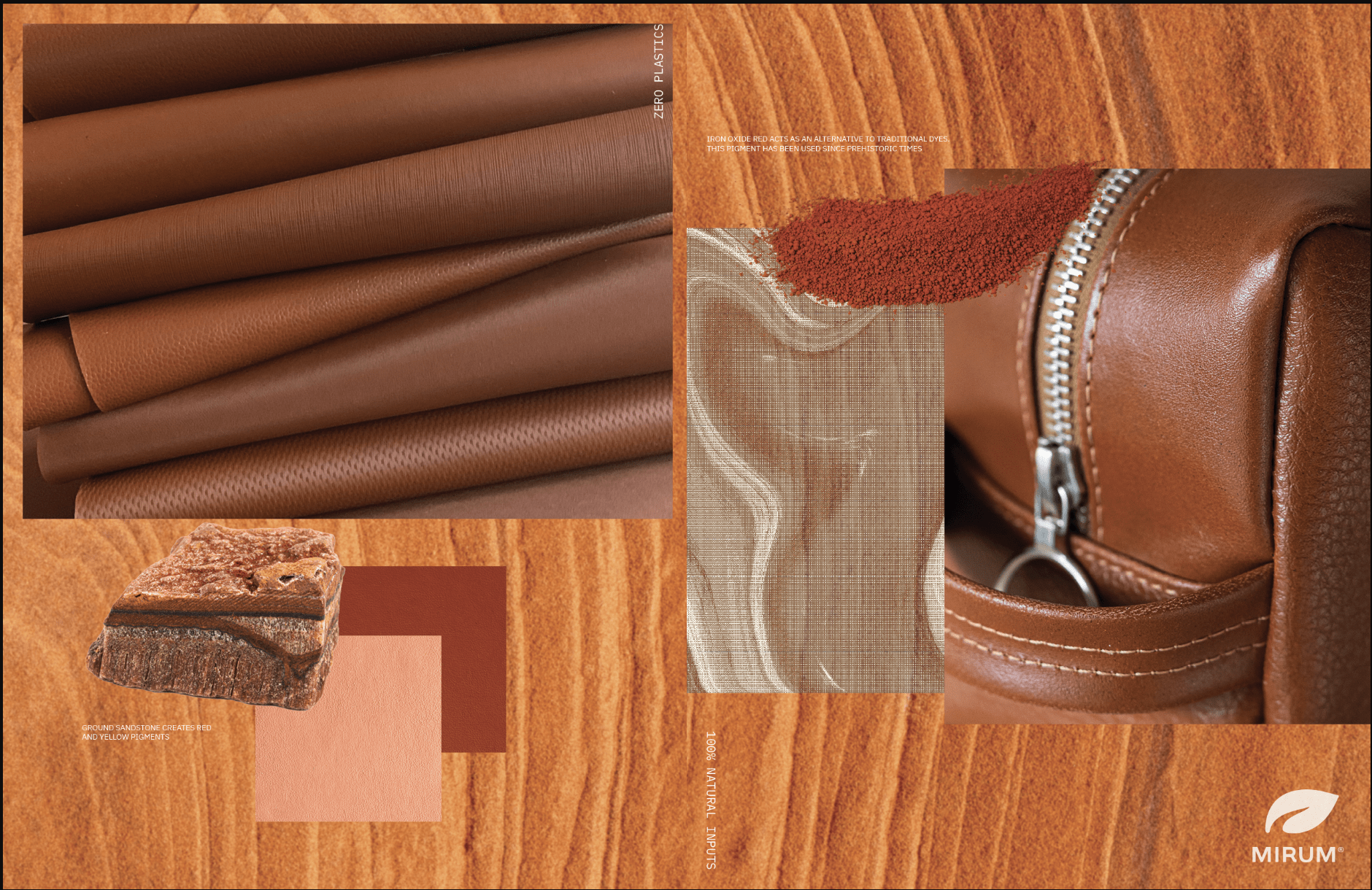

About Natural Fiber Welding (NFW)
NFW has developed a series of chemical and engineering solutions in a ‘technology platform’ that optimises the performance characteristics of the natural polymers – primarily cellulose. Their outputs include the knitting and weaving yarn Clarus and the non-woven material Mirum, an alternative to leather.
About Mirum
Mirum contains 100% plant polymers from virgin or waste sources, including cork, coconut husk and rice hull. The other ingredients are natural rubber, vegetable oils, minerals, structural colourant and NFW’s patented plant-based curative (a binding agent).
The proportions of these ingredients determine Mirum’s aesthetic and performance characteristics, which are, therefore, ‘tunable’ according to end-use.
Mirum is made by dry-mixing the input materials and then mechanically forming them into sheets. The sheets can then be backed with fabric in a moulding technique (without adhesives), and the Mirum surface can be embossed to a textured look and feel1.
Points of technical and aesthetic difference
Mirum, unlike almost all other plant-based ‘leathers’, contains no synthetic polymers. Polyurethane (PU) is often added to alternative ‘leathers’ to achieve the required functional characteristics, along with synthetic coatings derived from petrochemicals. The inclusion of synthetic chemicals reduces or prevents the recyclability of the material.
In the case of Mirum, it is 100% recyclable and biodegrades innocuously.
When plant ‘leather’ that contains synthetic polymers biodegrades, it sheds microplastics into the environment.
Mirum’s full environmental impacts will no doubt be updated once commercial production volumes are reached, but current data is available on the NFW website2.
Points of impact reduction
Cellulose is nature’s most abundant polymer – a naturally renewable feedstock. Apart from the ingredients listed above, NFW’s technology platform’s other main input is electrical energy.
NFW can trace their feedstock back to the source and operates material production ‘under one roof, providing access to primary data to quantify environmental impacts accurately. The transparency of their supply chain appears to be both a technical and competitive advantage, as explained later in this spotlight.
The apparent impact reduction advantages beyond the feedstock are eliminating synthetic chemicals and renewable-energy powered production.
Disruption potential and route to disruption
With the current facility, NFW will produce 100,000 sq.ft of Mirum per month by the end of 2022. In parallel, NFW’s engineers are installing automation that will come online next year and allow 1M to 2M sq.ft per month of Mirum production. The automated production has been trialled already. During a recent interview with NFW’s CEO, Luke Haverhals, he explained that increased capacity would be necessary to meet demands from other industries, including automotive (from BMW and others).
In addition, NFWs technology platform is repeatable and scalable, so it could be installed in manufacturing hubs to facilitate streamlined product manufacturing using Mirum. With the global leather market producing “tens of billions of square feet per year”, according to Haverhals, the scope for cornering sizeable market share is vast.
Route to commercialisation
NFWs materials science has “crossed the finish line in substantial and repeatable ways”, as explained by Haverhals. “The technology is not the problem – now it’s the business details.” NFW are now talking to high-growth investors, whom Haverhals says can see Mirum in the market and talk to people [using the material] in the supply chain. The company is now preparing for a Series C raise.
Comparisons/Limitations
Limitations have included difficulty winning over VC investors, says NFW’s CEO, with their comparatively pragmatic technology compared to some of the ‘sexier’ genetically engineered materials solutions vying for VC funding. But reaching small but commercial production volumes at a faster rate than competitors has helped the company progress to the growth funding stage sooner.
Haverhals says brands using Mirum report that it meets the expectations they would place on leather regarding aesthetics and performance. However, Mirum is a new material that has not yet endured long-term consumer use, so its aesthetic qualities and performance over time, compared to animal leather, are not yet known.
Haverhals also revealed during the interview that NFW have 1500 brands on their customer relationship platform who were driven to NFW for a key reason: “they can get the information they need” from NFW regarding traceability and impact. “Our technology is a circularity of things platform. We are a circularity of things company”.
Barriers to success
Haverhals is optimistic about the road to success: “I see an open pathway to the finish line, but any number of things could happen. I didn’t anticipate Russia invading Ukraine. I didn’t predict the inflation increase [and] sometimes things get stuck in the Suez canal.” But with established brand partnerships (including Allbirds, with others to be announced later this year) and manufacturing partner Veshin Factory3, Mirum’s profile and production volumes are rising.
“Customers are telling us that this material is a direct replacement for all types of leather – a total solution”
Luke Haverhals, CEO, Natural Fiber Welding

